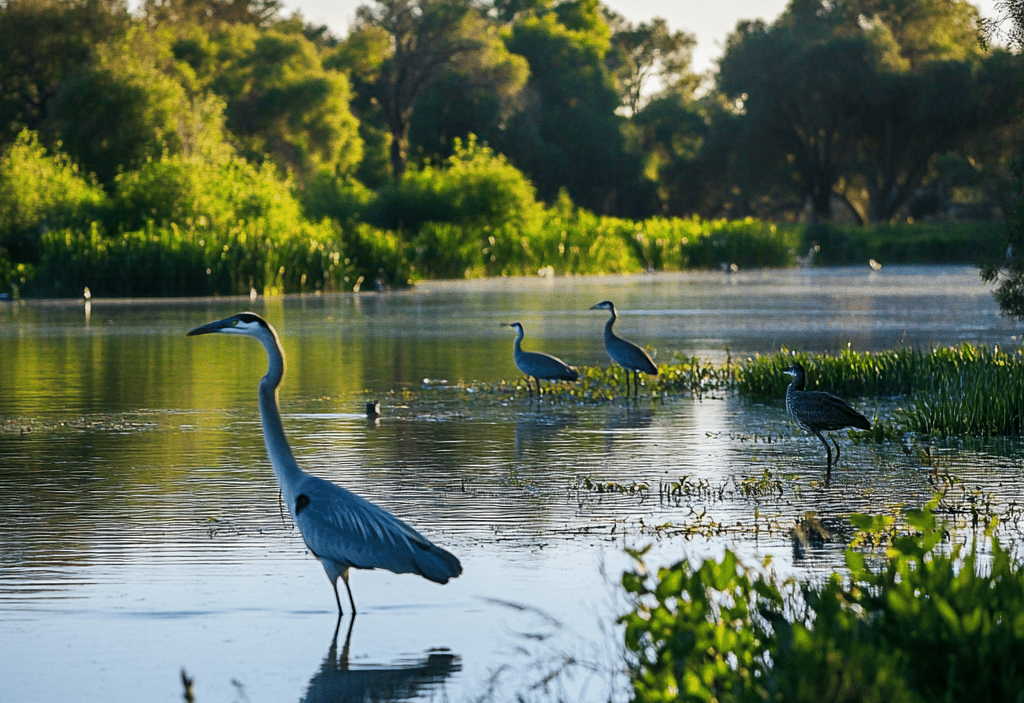The vibrant world of birdwatching in Elk Grove, California, offers diverse habitats that attract a remarkable variety of bird species throughout the year. Whether you’re an experienced birder or just starting to develop an interest in our feathered friends, Elk Grove provides excellent opportunities to observe birds in their natural habitats. This guide will help you discover the best locations and identify the fascinating bird species that call Elk Grove home.
Top Birdwatching Destinations in Elk Grove
Elk Grove Regional Park stands as a premier birdwatching location in the city. This expansive 122-acre park features a beautiful lake that attracts numerous waterfowl species, making it a year-round hotspot for bird enthusiasts. The park’s ecosystem includes open water, cattail marshes, and wooded areas, creating microhabitats for a variety of birds. Visitors will appreciate the park’s excellent amenities, including well-maintained walking paths, ample parking, clean restrooms, and picnic areas perfect for taking a break between birding sessions.
The park is particularly accessible for birders of all abilities, with paved trails suitable for wheelchairs and strollers. Early mornings at Elk Grove Regional Park offer the best birdwatching opportunities, when you might spot Great Blue Herons stalking the shallows, Acorn Woodpeckers working on their granary trees, or even a Cooper’s Hawk soaring overhead. The western section of the park, with its mature oak trees, provides excellent habitat for woodland species, while the lake area is ideal for observing ducks, geese, and occasionally migrating shorebirds.
Stone Lakes National Wildlife Refuge represents a crucial conservation area just west of Elk Grove. This 6,000-acre refuge contains one of the few remaining wetland habitats in the Sacramento Valley, providing an essential sanctuary for migratory birds traveling along the Pacific Flyway. The refuge’s managed wetlands, grasslands, and riparian habitats create a mosaic of ecosystems that support over 200 bird species.
During winter months, visitors can witness spectacular concentrations of waterfowl, including thousands of Snow Geese and Greater White-fronted Geese that transform the sky with their massive flocks.
The refuge offers multiple access points with varying facilities. The Blue Heron Trails area provides a visitor kiosk, interpretive signs, and accessible pathways that lead to observation platforms overlooking the wetlands.
For a more immersive experience, seasonal guided tours (usually available September through May) take visitors to limited-access areas of the refuge where you might spot Sandhill Cranes, American White Pelicans, or even the occasional Bald Eagle. The refuge’s commitment to habitat restoration has made it increasingly valuable for birds, with viewing opportunities improving each year as native vegetation becomes established.
Laguna Creek Parkway offers a different type of birding experience with its linear nature and riparian corridor. This greenbelt follows Laguna Creek for several miles, creating a natural corridor for birds moving through urban areas. The parkway’s combination of flowing water, streamside vegetation, and adjacent grasslands attracts a diverse community of birds throughout the seasons. The well-maintained trail system makes this location particularly accessible, with multiple entry points from surrounding neighborhoods allowing birders to explore different sections of the creek.
The parkway stands out as a birding location during spring migration when colorful warblers, vireos, and flycatchers can be spotted moving through the trees and shrubs. Year-round residents include Anna’s Hummingbirds, California Towhees, and Bewick’s Wrens that can be found foraging in the understory.
The parkway’s facilities include interpretive signage about local wildlife, benches placed at scenic viewing points, and connections to the city’s broader trail network. The Camden Creek section of the parkway is especially productive for birdwatching, where the habitat transitions between dense riparian forest and more open grassland, creating edge habitat that many species prefer.
Elk Grove’s Bird Species Guide
Elk Grove hosts a remarkable variety of resident bird species that can be observed throughout the year. The California Scrub-Jay, with its blue and gray plumage and bold personality, is one of the most recognizable birds in local neighborhoods. These intelligent corvids are often seen foraging on the ground or announcing their presence with harsh calls from prominent perches.
House Finches represent another common year-round resident, with males displaying distinctive red coloration on their heads and breasts. These social birds frequently visit backyard feeders and can be spotted in small flocks, their cheerful warbling songs adding a pleasant soundtrack to outdoor activities.
Other notable resident species include the Oak Titmouse, a small gray-brown bird with a distinctive crest that depends on oak woodlands for nesting cavities, and the Anna’s Hummingbird, which has adapted well to suburban landscapes and can be seen visiting flowering plants year-round. The White-crowned Sparrow, with its bold black and white striped head, becomes particularly common during winter months.
When seeking these resident birds, focus on areas with mature trees, especially native oaks, mixed with open spaces that provide the habitat diversity these species prefer. Early morning hours typically offer the best viewing opportunities when birds are most active and vocal.
Elk Grove’s position along the Pacific Flyway makes it a temporary home for numerous migratory birds. During spring and fall migrations, the city’s waterways and green spaces become vital stopover points for birds traveling between their breeding and wintering grounds. Colorful warblers like the Yellow-rumped Warbler and Wilson’s Warbler pass through in waves, gleaning insects from trees and shrubs.
Shorebirds, including Greater Yellowlegs and Western Sandpipers, can be spotted in temporarily flooded fields and along muddy edges of waterways, especially after spring rains create shallow pools that concentrate aquatic invertebrates.
The winter months bring an influx of waterfowl to Elk Grove’s wetland areas, with Northern Shovelers, Green-winged Teal, and Bufflehead ducks adding color and activity to local ponds and lakes. Stone Lakes National Wildlife Refuge becomes particularly important during this season, hosting impressive numbers of geese and Sandhill Cranes.
Birders hoping to maximize their species count should learn to identify birds by their calls and songs, as many species announce their presence vocally before they’re seen. The melodious songs of White-crowned Sparrows, the “fee-bee” calls of Black-capped Chickadees, and the distinctive “oak-a-lee” of Red-winged Blackbirds are just a few of the sounds that help birders locate and identify Elk Grove’s diverse avian residents.
Elk Grove’s community has embraced bird conservation with several initiatives that help protect and enhance bird habitats within the city limits. Local conservation efforts focus on preserving riparian corridors, managing urban green spaces with birds in mind, and restoring native vegetation in parks and public areas.
The city’s urban forest management program maintains the mature trees that provide crucial nesting sites for cavity-nesting birds like woodpeckers and nuthatches. Meanwhile, community science projects engage residents in monitoring bird populations, with data contributing to a broader understanding of bird distribution and abundance changes over time.
Several local organizations offer opportunities for bird enthusiasts to get involved in conservation activities. The Sacramento Audubon Society conducts regular bird surveys and habitat restoration events in Elk Grove, welcomes volunteers of all experience levels, and provides educational programs about local birds.
For those interested in developing their bird identification skills, focusing on learning the distinctive calls of common local species offers a rewarding challenge. The melodic “teacher-teacher-teacher” song of the Ovenbird, the rapid drumming of woodpeckers, and the iconic “who-cooks-for-you” call of the Barred Owl are signature sounds that help birders connect with Elk Grove’s avian residents even when the birds themselves remain hidden from view.






